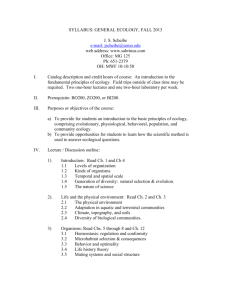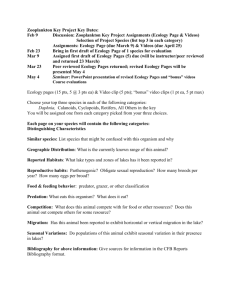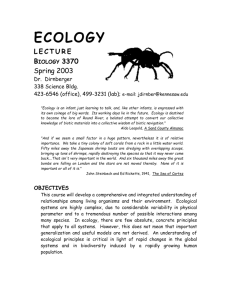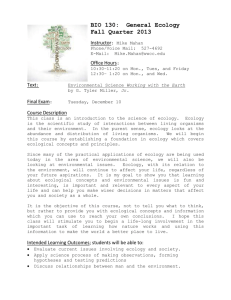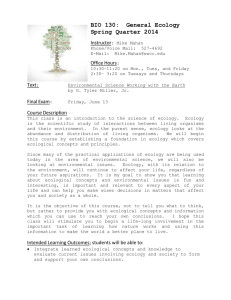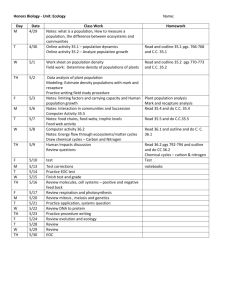Ecology 203, Exam I
advertisement
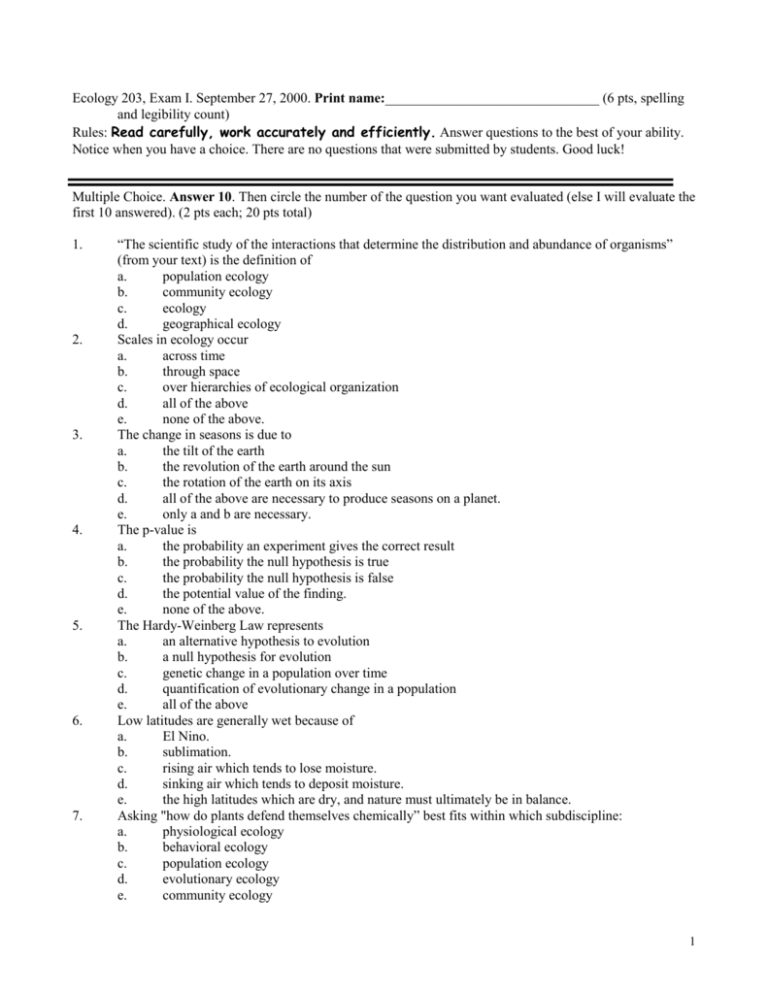
Ecology 203, Exam I. September 27, 2000. Print name:_______________________________ (6 pts, spelling and legibility count) Rules: Read carefully, work accurately and efficiently. Answer questions to the best of your ability. Notice when you have a choice. There are no questions that were submitted by students. Good luck! Multiple Choice. Answer 10. Then circle the number of the question you want evaluated (else I will evaluate the first 10 answered). (2 pts each; 20 pts total) 1. 2. 3. 4. 5. 6. 7. “The scientific study of the interactions that determine the distribution and abundance of organisms” (from your text) is the definition of a. population ecology b. community ecology c. ecology d. geographical ecology Scales in ecology occur a. across time b. through space c. over hierarchies of ecological organization d. all of the above e. none of the above. The change in seasons is due to a. the tilt of the earth b. the revolution of the earth around the sun c. the rotation of the earth on its axis d. all of the above are necessary to produce seasons on a planet. e. only a and b are necessary. The p-value is a. the probability an experiment gives the correct result b. the probability the null hypothesis is true c. the probability the null hypothesis is false d. the potential value of the finding. e. none of the above. The Hardy-Weinberg Law represents a. an alternative hypothesis to evolution b. a null hypothesis for evolution c. genetic change in a population over time d. quantification of evolutionary change in a population e. all of the above Low latitudes are generally wet because of a. El Nino. b. sublimation. c. rising air which tends to lose moisture. d. sinking air which tends to deposit moisture. e. the high latitudes which are dry, and nature must ultimately be in balance. Asking "how do plants defend themselves chemically” best fits within which subdiscipline: a. physiological ecology b. behavioral ecology c. population ecology d. evolutionary ecology e. community ecology 1 8. 9. 10. 11. 12. 13. Which of the following is not a "learning objective" of this course: a. To understand how the process of science operates and how it is used to understand how organisms interact with each other and their environment. b. To understand how the process of evolution operates and how it influences the dynamics of ecological systems. c. To be able to critically analyze biological data, both in a statistical sense and in graphical forms. d. To further your understanding of how evolution is based on science and reason. e. To be able to interpret the news. Trofim Lysenko a. employed the methods of science to support his beliefs of how plants compete. b. accepted that Darwin was right about evolution but wrong about its mechanism, competition. c. was exiled to Siberia for promoting Lamarkism as the mechanism of evolution. d. all of the above. e. none of the above. The SUNY Geneseo Roemer Arboretum contains the following: a. open grass communities b. shrub and forest communities c. stream communities d. more than 100 species of plants e. all of the above. The following is not an aspect of science a. Conclusions are provisional b. Conclusions must support the null hypothesis c. Conclusions, if important, will be tested by others and reversed if wrong d. They are all aspects of science e. None of them is an aspect of science. Organisms are generally limited by a. the availability of a single limiting factor b. the availability of many limiting factors c. the abundance of the saturating factor d. all of the above may limit organisms. e. there are no generalizations about this in ecology Which of the following is not a use for models in ecology: a. to generate hypotheses b. to make predictions c. to test hypotheses d. all of the above are uses for models e. none of the above come from the use of models. True-False – circle T for true, F for false. Answer seven of the nine (2 pts each; 14 pts total). T F Cold-blooded organisms (fish and insects) have no mechanisms to control their body temperatures. T F Some plants are able to change their metabolic rates, effectively controlling their own temperatures. T F Models of ecological systems are not really useful because of environmental fluctuations. T F Natural selection has never actually been observed in the natural world. T F Statistics are both procedures used to understand data and summary values of data. 2 T F "Population," in statistical sense, is the group of organisms we actually sample to study. T F In science we try to prove only the null hypothesis either true or false. T F A fish that lives in salt water must drink. T F The field guide discusses “succession.” This is a series of adaptations that take place over long periods of time. Succinctly define/discuss two of the following in the space provided. (5 pts each; 10 pts total) Niche Null hypothesis C3, C4, CAM photosynthesis Inference Falsifiability Species Directional selection Statistical significance Counter-current exchange mechanism Human (or artificial) selection Formation of the Hawaiian Islands Allopatric speciation 3 Short answers. Answer two of five. (15 pts each 30 pts total) 1. Briefly and succinctly discuss your conclusion from this figure. (Think quantitatively.) 2. Discuss the problems associated with clutch size in birds, based on the work by David Lack on the common swift. 3. Why do birds migrate? 4 4. Compare “disruptive selection” with “stabilizing selection” using examples. Graphs are OK to include! 5. What would cause continental plates to break and drift apart (a physics question)? Answer the following two questions. (10 pts each, 20 pts total) 1. What are the four, easily observed characteristics of natural selection? Give sufficient detail to show you know and understand what they are. 5 2. Discuss the process involved in testing the hypothesis that women are smarter than men. Include the basic scientific method, the various hypotheses. Provide some data (you can make it up) in a graphical form, form a conclusion and support it with the evidence in your graph. 6
